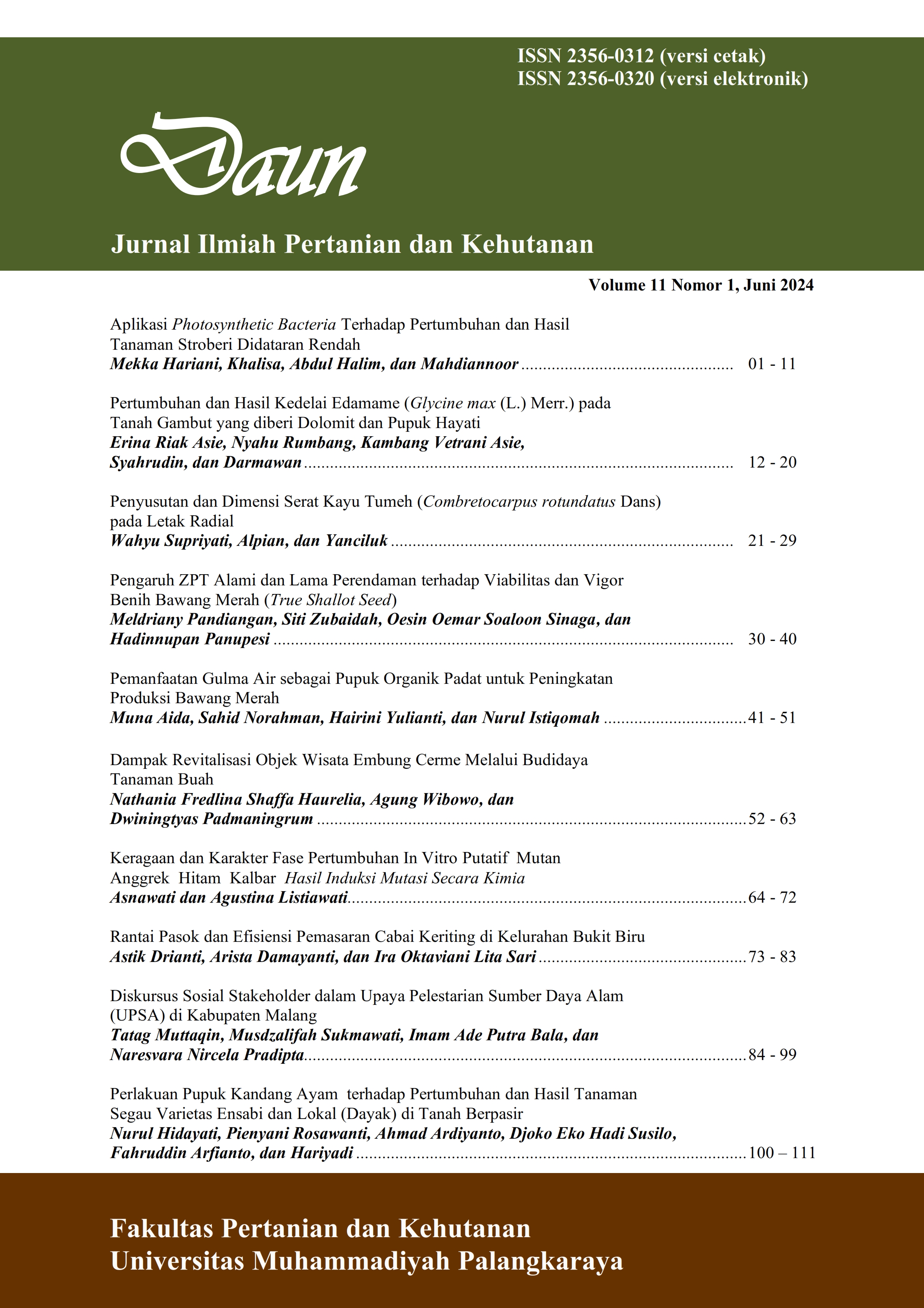Pertumbuhan dan Hasil Kedelai Edamame (Glycine max (L.) Merr.) pada Tanah Gambut yang diberi Dolomit dan Pupuk Hayati Growth and Yield of Edamame Soybeans (Glycine max (L.) Merr.) on Peat Soils Supplied with Dolomite and Biofertilizer
Main Article Content
Abstract
Edamame soybeans are soybeans that are harvested young so they are known as green soybeans. The high nutritional content and delicious taste make edamame soybeans popular with the public, so they have the potential to be developed. One effort to increase edamame production is through expanding the planting area (Extensification). One type of soil that has the potential for expanding edamame soybean plants is peat soil. This research aims to examine the effect of dolomite and biofertilizer on the growth and yield of edamame on peat soil. The experiment was carried out using a two-factor factorial Completely Randomized Design (CRD) with three replications. The first factor, namely dolomite (0, 5, 10, 15 t ha-1) and the second factor, namely biofertilizer (0, 5, 10, 15 g kg-1 seed). The research results showed that the interaction between dolomite and biofertilizer and the single factor of biofertilizer had no significant effect on the growth and yield of edamame soybeans. Theresults showed that the interaction between dolomite and biofertilizer and the single factor of biofertilizer had no significant effect on the growth and yield of edamame soybeans. The application of dolomite can increase leaf area, plant dry weight, number of pods, and fresh pod weight plant-1 of edamame soybean plants on peat soil.
Keywords: extensification, edamame, dolomite, biofertilizer, peat soil
Downloads
Article Details

This work is licensed under a Creative Commons Attribution-ShareAlike 4.0 International License.
All rights reserved. This publication may be reproduced, stored in a retrieval system, or transmitted in any form or by any means, electronic, mechanical, photocopying, recording.
References
Abiyot Abeje, Getachew Alemayehu, Tesfaye Feyisa. (2021). Nodulation, Growth, and Yield of Soybean (Glycine max L. Merrill) as Affected by Bio- Organic, and Inorganic NPSB Fertilizers, and Lime in Assosa Zone, Western Ethiopia. International Journal of Agronomy, vol. 2021, Article ID 1285809, 12pages,2021. https://doi.org/10.1155/2021/1285809.
Alemayehu Dabesa & Tamado Tana. (2021). Response of Soybean (Glycine max L. (Merrill)) to Bradyrhizobium Inoculation, Lime, and Phosphorus Applications at Bako, Western Ethiopia, International Journal of Agronomy, vol. 2021, Article ID 6686957, 12 pages, 2021. https://doi.org/10.1155/2021/6686957
Anggara. A. S. (2020). Nestapa Gambut Nusantara. (https://kaltengpos.co/berita/-48306 nestapa_gambut_nusantara.html) (Verifed 29 Maret 2023).
Dinas Lingkungan Hidup. (2018). APBN-Tugas Pembantuan Restorasi Gambut Dinas Lingkungan Hidup Provinsi Kalimantan Tengah Tahun 2018. Palangka Raya.
Fitriatin, B.N. (2023). Teknologi Inovatif Berbasis Pupuk Hayati Pelarut Fosfat dalam Mewujudkan Pertanian Berkelanjutan”. Orasi Ilmiah. https://www.unpad.ac.id/2023/09/pakar-unpad- penggunaan-pupuk-hayati- wujudkan-pertanian- berkelanjutan/ (verified 2 November 2003).
Hardjowigeno, S. (2015). Ilmu Tanah. Akademika Pressindo. Jakarta.
Htwe, A. Z., Moh, S. M., Moe, K., & Yamakawa, T. (2019). Biofertilizer Production for Agronomic Application and Evaluation of Its Symbiotic Effectiveness in Soybeans. Agronomy, 9(4), 162. https://doi.org/10.3390/agronomy9040162
Irwan, A. W., & Nurmala, T. (2018). Pengaruh Pupuk Hayati dan Pengapuran terhadap Produktivitas Kedelai di Tanah Inceptisol Jatinangor. Kultivasi, 17(2), 656- 663.DOI:https://doi.org/10.24198/kultivasi.v17i2.18 117
Irwan, A. W. & Wicaksono, F. Y. (2017). Perbandingan Pengukuran Luas Daun Kedelai Dengan Metode Gravimetri, Regresi dan Scanner. Jurnal Kultivasi16(3):425–429.DOI: https://doi.org/10.24198/kultivasi.v16i3.14448
Jumakir, J., Endrizal, E., & Suyamto, S. (2017). Uji Beberapa Paket Pemupukan Dan Dolomit Terhadap Hasil Kedelai Di Lahan Rawa Pasang Surut Provinsi Jambi. Jurnal Lahan Sub optimal: Journal of SuboptimalLands,5(1),86–94. https://doi.org/10.33230/JLSO.5.1.2016.236.
Lestari, W. S., & Jumin, H. B. (2023). Pengaruh Dolomit dan Hydrilla verticillata terhadap Pertumbuhan serta Produksi Tanaman Kedelai (Glycine max (L.) Merril) pada Tanah Gambut. Jurnal Agroteknologi Agribisnis dan Akuakultur, 3(1),109-124.DOI: https://doi.org/10.25299/jaaa.v3i1.12277
Mu'min, M., Numba, S., & Galib, M. (2021). Pengaruh Inokulasi Rhizobium dan Pupuk Organik Cair terhadap Pertumbuhan dan Hasil Tanaman Kedelai (Glycine max (L. Merr). Agrotekmas, Jurnal Indonesia: Jurnal Ilmu Pertanian, 2(3), 7-18. DOI: prefix 10.33096
Nawawi, M. Imam., Fitriyah. N., & Wasito. (2017). Pengaruh Dosis Pupuk Hayati dan Pupuk Fosfat Terhadap Pertumbuhan dan Produksi Tanaman Kedelai Edamame (Glycine max (L.) Merril) Varietas Ryokkoh 75. Jurnal Ilmiah Hijau 3 (2): 1-14. DOI: https://doi.org/10.32503/hijau.v3i2.272
Ni’am, A. M., & Bintari, S. H. (2017). Pengaruh Pemberian Inokulan Legin dan Mulsa terhadap Jumlah Bakteri Bintil Akar dan Pertumbuhan Tanaman Kedelai Varietas Grobogan. Indonesian Journal of Mathematics and Natural Sciences,40(2),80-86. DOI: https://doi.org/10.15294/ijmns.v40i2.12566
Noor, M. (2010). Lahan Gambut: Pengembangan, Konservasi, dan Perubahan Iklim. Gadjah Mada University Press. Yogyakarta.
Nuraini, Nugroho, A., Indriyati, B., & Lilik T. (2020). Pengaruh Dolomit terhadap Pertumbuhan dan Serapan Ca dan Mg Kedelai (Glycine max (L) Merr) pada Podsolik Jasinga. URI http://repository.ipb.ac.id/handle/123456789/10251. (Verified: 8 November2023).
Nurhayati, N. (2020). Pengaruh Pemberian Amandemen Pada Tanah Gambut Terhadap pH Tanah Gambut Dan Pertumbuhan Vegetatif Tanaman Kedelai. Wahana Inovasi: Jurnal Penelitian dan Pengabdian Masyarakat UISU, 9(1), 1-8. ISSN: 2089-8592
Pieter, Y., & Mejaya, M. J. (2018). Pengaruh Pemupukan Hayati terhadap Pertumbuhan dan Hasil Kedelai di Lahan Sawah. Penelitian Pertanian Tanaman Pangan, 2(1),51-57.DOI: http//dx.doi.org/10.21082/jpptp.v2n1.2018.p51-57
Sudiarti D. (2017). The Effectiveness of Biofertilizer on Plant Growth Soybean Edamame (Glycine max (L.) Merril). Jurnal SainHealth 1 (2): 97-106. DOI: http://dx.doi.org/10.51804/jsh.v1i2.110.97-106
Wijaya, K. A. (2020). Nutrisi Tanaman. Andi Offset. Yogyakarta.
Yuniar, M., Susanti, H., & Fredrickus, B. (2021). Respon Pertumbuhan dan Hasil Tanaman Kailan Terhadap Pemberian Kapur Dolomit dan Pupuk Bokashi Kotoran Sapi di Tanah Gambut. EnviroScienteae, 17(3),116-126.DOI: http://dx.doi.org/10.20527/es.v17i3.11815.
